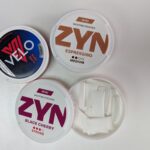- Formula One cars have not sported tobacco branding since 2006, but Big Tobacco are finding ways to get back on the track.
- Both McLaren and Ferrari have had team gear and cars that promote vapes and nicotine pouches to a young, global audience.
- Although these products are not like traditional smokes, their nicotine can get you hooked and make you reach for old-fashioned tobacco products later — which are bad for people’s health.
- South Africa’s new tobacco Bill will ban all broadcasts that contain tobacco branding. Could this put F1 broadcasts at risk?
In today’s newsletter Christina Pitt tells you how big tobacco companies are finding a way around advertising bans by sponsoring Formula 1 and video racing games Sign up.

The car sported a striking wavy polka-dot design in papaya orange and ocean blue on each side and the front wings.
But its most prominent feature was the logo for the e-cigarette brand Vuse splashed across the design.
In November 2023, Formula One (F1) team McLaren revealed their newly branded racing car, featuring a paint job by the Saudi Arabian artist Nujood Al-Otaibi ahead of the Abu Dhabi Grand Prix that month.
For the past three years, artists like Al-Otaibi, who has a hearing problem, showed their work through British American Tobacco’s (BAT) “Driven by Change” initiative. By partnering with McLaren and Driven by Diversity, they want to make motorsports accessible to everyone, they say.
The catch is that their designs are used to promote a BAT product — in this case its e-cigarette brand Vuse. Putting a bright spin on tobacco — even for non-traditional products such as vapes — is an old industry trick.
E-cigarettes (aka vapes) are electronic devices that heat a nicotine-containing liquid to produce a vapour that the user inhales. Nicotine, which comes from tobacco leaves, is the drug that gets you hooked on tobacco products like traditional cigarettes and cigars, which is why experts warn that vaping could entice non-smokers to start using tobacco.
This is bad news for people’s health, as research has convincingly shown that the chemicals people inhale when smoking traditional cigarettes help to cause cancer, lung problems and heart disease.
As a member of the World Health Organisation’s (WHO) anti-smoking treaty since 2005, South Africa promised to make laws that will clamp down on advertising of tobacco products to stop people from picking up the habit.
Because e-cigarettes could push someone to start smoking, the minister of finance has placed a sin tax on vapes similar to the tax on tobacco products, and the planned new Bill proposes that vape advertising should be controlled in the same way as tobacco advertising.
In 2021, 12.7-million South Africans used tobacco, with just over 11-million of them getting their fix from smoking. The habit cost the country R42-billion in lost productivity and healthcare expenses already back in 2016, with treatment for smoking-related illnesses such as cancer, heart problems and lung disease accounting for about 4% of what the country spent on healthcare that year, an analysis shows. Moreover, close to 26 000 people are thought to have died from smoking that year — close to 40% of Aids deaths then.
But the planned Tobacco Products and Electronic Nicotine Delivery Systems Control Bill has been sitting in limbo on politicians’ desks for the last five years, and the current Tobacco Products and Control Act only prohibits some types of marketing, but not all.
For example, smoking and tobacco products shown in international broadcasts are allowed and the tobacco industry may sponsor an activity or event as long as it isn’t used to drive up sales. In contrast, film material produced locally may not show any smoking and it can’t be advertised in magazines or newspapers, on billboards or on TV or radio.
In the meantime, while lawmakers are dawdling to decide on the new Bill, tobacco companies like BAT and Philip Morris International (PMI) have found ways to get around the proposed stricter rules on vapes — not only in South Africa but elsewhere too — by tapping into F1’s fan base to punt their products.
What drives tobacco companies to sponsor F1?
In 2022, 1.5-billion people across the world watched F1 races on TV — and with 24 races (the most in F1’s history) in 21 countries on this year’s calendar, the world viewership is likely to grow. Phil Chamberlain, deputy director of Tobacco Tactics, an information hub that’s part of the Tobacco Research Control Group at the University of Bath, says this expansion means that the tobacco industry will also have greater access to people in these regions. This can be good news for Big Tobacco, who is facing a dwindling consumer base because of stricter tobacco control measures — about 110 million fewer people used tobacco in 2022 than in 2000, a new WHO report shows.
“The tobacco industry wants to align itself with the [image of] health, glamour and technology that F1 represents,” Chamberlain explains. Sponsoring races that are broadcast on TV can therefore drive up brand awareness, improve a brand’s image and push up sales.
When Fédération Internationale de l’Automobile (FIA), the governing body that oversees the commercial and safety affairs of motor racing, decided in 2001 to ban tobacco sponsorship, all cigarette branding seemingly disappeared.

But in 2019 British American Tobacco signed a deal with McLaren to promote their purportedly benign products such as vapes and nicotine pouches by branding cars and using aspirational taglines such as “Better Tomorrow” and “Accelerating Change” on team gear, according to a report by tobacco industry watchdog Stop.
In 2018, PMI had a similar strategy by putting their Mission Winnow logo, which promotes “potentially reduced risk” products such as vapes, on Ferrari’s cars and team wear. Although the logo has not been seen on gear or the cars for the last three years, Mission Winnow is listed as a team partner on the Ferrari racing website.
Chamberlain says pitching tobacco products in this way is hypocritical. “If PMI and BAT say they’re trying to provide safer alternatives to cigarette smoking, why do they still sell cigarettes?”
While you were streaming
Social media, video game racing (also called e-sports) and online streaming platforms are fertile ground for attracting a new generation of consumers to tobacco products — and vapes and nicotine pouches (a tiny bag of a flavoured nicotine-containing powder that slowly dissolves when in your mouth, like a lozenge) can be just the hook to draw people in.
“The industry’s customers have died from cancer and now they’re looking for young people to replace them,” says Chamberlain.
According to the Stop report, about a third of the 2022 season of Formula 1: Drive to Survive, a documentary series on Netflix that follows the off-track drama of racing, showed tobacco-related branding, amounting to just over 1-billion minutes of airtime globally.
Moreover, all of the season’s episodes had shown tobacco-related branding at some point during the first four minutes, with half of them having it in the opening minute. This makes it likely that almost every viewer of this series saw some visuals pointing to tobacco products.
An analysis by Nielsen Sports found that the show appealed to a new audience in the United States (US) that are younger than viewers who watch just the F1 races on TV (about half are younger than 34, whereas only one in eight F1-alone viewers fall in this age group).

Research has shown that teenagers who see tobacco advertising are more likely to experiment with smoking, and it might extend to vapes too.
A 2020 study across some 14 000 people between the ages of 15 and 21 in the US found that those who saw images of vaping in programmes on Netflix and cable TV were up to three times more likely to start vaping than peers who’ve not seen such visuals.
Pulmonologist Richard van Zyl-Smit, whose research group ran a pilot study about the use of vapes among South African high school learners, told Bhekisisa that they’ve found parents were buying e-cigarettes for their kids because of the (industry-punted) perception that they’re safer than cigarette smoking.
But Robert Jackler, a medical doctor and tobacco marketing researcher at Stanford University in the US says that nicotine in vapes is also bad for kids because of the way it affects the chemical messengers in their developing brains. Nicotine addiction is difficult to break [and the substance] primes their brains for addiction to other drugs.”
Will SA’s planned new law keep kids safe?
Although research shows that strict advertising rules can lower the number of new smokers, they don’t work as well as they should if the bans don’t cover all forms of advertising. South Africa’s planned new tobacco Bill is a step forward in that any kind of marketing, including in local and international broadcasts, on TV or online, will be banned.
However, enforcing these rules is likely to be a hot potato.
Chairperson of the school of health systems and public health at the University of Pretoria, Lekan Ayo-Yusuf, says such tobacco regulation “can only work if all countries work together to ban tobacco sponsorship in broadcasts”.
But according to a 2023 WHO report, only 66 out of the 195 countries surveyed blocked all forms of advertising, including on TV and radio, in magazines and newspapers, on billboards and at till points in shops. The remaining 129 had only some rules in place (and 40 of these had very little control measures). This means the tobacco industry could carry on marketing their products lawfully in many countries.
When it comes to tobacco-sponsored F1 racing, patchy policies, like South Africa’s, mean that for events held in countries where branding is legal, like in Monaco, tobacco marketing can still reach audiences despite in-your-face advertising being banned.
Another possible loophole in South Africa’s new law sits in how a tobacco product is defined. Ayo-Yusuf explains that a product that contains lab-made nicotine rather than it being derived from natural sources such as tobacco leaves — which is what the makers of the Velo nicotine pouch claim — won’t be covered by the advertising rules proposed in the Bill because they aren’t explicitly listed in the document.
As for the FIA’s stance on tobacco branding, senate member Anton Roux says they’re not concerned that the proposed new Bill will thwart F1 broadcasting in South Africa, as a ban like that would mean the broadcaster would have to fork out extra money to check content before it’s aired.
“The broadcasters could just decide not to buy the rights to F1 because of the cost, and fans will [be stuck with having] to watch international darts instead.”
Christina Pitt is a health journalist at Bhekisisa.







